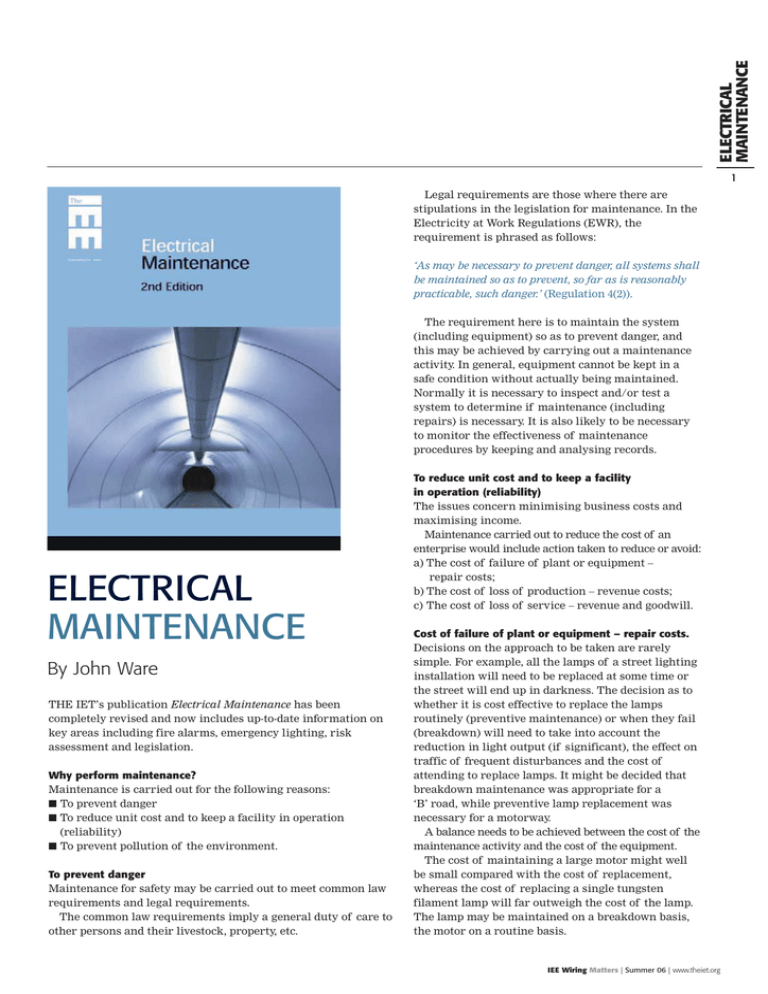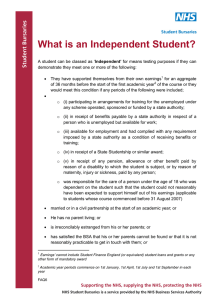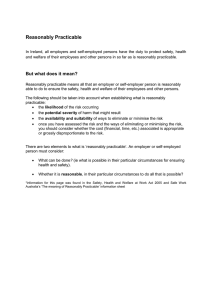
ELECTRICAL
MAINTENANCE
1
Legal requirements are those where there are
stipulations in the legislation for maintenance. In the
Electricity at Work Regulations (EWR), the
requirement is phrased as follows:
‘As may be necessary to prevent danger, all systems shall
be maintained so as to prevent, so far as is reasonably
practicable, such danger.’ (Regulation 4(2)).
The requirement here is to maintain the system
(including equipment) so as to prevent danger, and
this may be achieved by carrying out a maintenance
activity. In general, equipment cannot be kept in a
safe condition without actually being maintained.
Normally it is necessary to inspect and/or test a
system to determine if maintenance (including
repairs) is necessary. It is also likely to be necessary
to monitor the effectiveness of maintenance
procedures by keeping and analysing records.
ELECTRICAL
MAINTENANCE
By John Ware
THE IET’s publication Electrical Maintenance has been
completely revised and now includes up-to-date information on
key areas including fire alarms, emergency lighting, risk
assessment and legislation.
Why perform maintenance?
Maintenance is carried out for the following reasons:
■ To prevent danger
■ To reduce unit cost and to keep a facility in operation
(reliability)
■ To prevent pollution of the environment.
To prevent danger
Maintenance for safety may be carried out to meet common law
requirements and legal requirements.
The common law requirements imply a general duty of care to
other persons and their livestock, property, etc.
To reduce unit cost and to keep a facility
in operation (reliability)
The issues concern minimising business costs and
maximising income.
Maintenance carried out to reduce the cost of an
enterprise would include action taken to reduce or avoid:
a) The cost of failure of plant or equipment –
repair costs;
b) The cost of loss of production – revenue costs;
c) The cost of loss of service – revenue and goodwill.
Cost of failure of plant or equipment – repair costs.
Decisions on the approach to be taken are rarely
simple. For example, all the lamps of a street lighting
installation will need to be replaced at some time or
the street will end up in darkness. The decision as to
whether it is cost effective to replace the lamps
routinely (preventive maintenance) or when they fail
(breakdown) will need to take into account the
reduction in light output (if significant), the effect on
traffic of frequent disturbances and the cost of
attending to replace lamps. It might be decided that
breakdown maintenance was appropriate for a
‘B’ road, while preventive lamp replacement was
necessary for a motorway.
A balance needs to be achieved between the cost of the
maintenance activity and the cost of the equipment.
The cost of maintaining a large motor might well
be small compared with the cost of replacement,
whereas the cost of replacing a single tungsten
filament lamp will far outweigh the cost of the lamp.
The lamp may be maintained on a breakdown basis,
the motor on a routine basis.
IEE Wiring Matters | Summer 06 | www.theiet.org
ELECTRICAL
MAINTENANCE
2
The IET’s Electrical Maintenance, 2006
Chapter 1 Legislation and guidance. Maintenance strategies.
Chapter 2 Risk assessment, manual handling, display screen regulations and safety signs and signals
Chapter 3 Electrical installations. The need for maintenance, periodic inspection and certificates
Chapter 4 Testing of electrical installations
Chapter 5 Lighting maintenance. Lamp cleaning and replacement policies
Chapter 6 In service inspection and testing of electrical equipment
Chapter 7 Emergency lighting
Chapter 8 Fire detection and alarm systems
Chapter 9 Industrial and commercial switchgear
So far as is reasonably practicable
Duties in some of the Regulations of the EWR, such
as Regulation 4(2) quoted previously, use the phrase
‘so far is as reasonably practicable’. Where this
qualifying term is absent, for example in Regulation
16 concerning competence, the regulation is said to be
absolute. The meaning of ‘reasonably practicable’ has
been well established in law. The interpretations
below are given as a guide both to administrators and
to persons inspecting and testing.
Chapter 10 Electromagnetic compatibility
Chapter 11 Lightning protection installations
Chapter 12 Environmental protection. The Waste Electrical and Electronic Equipment (WEEE) Directive.
Chapter 13 Legionellosis. Avoidance of the occurrence of Legionnaires disease from wet cooling
systems and water supply systems.
Loss of production – revenue costs. In many
situations the cost of the failed piece of equipment is
insignificant compared with the cost of loss of output
or production. In these circumstances breakdown
maintenance is unlikely to be appropriate.
Loss of service – revenue and goodwill. Customer
goodwill is difficult to estimate financially, but should
be considered, when determining maintenance
regimes. The additional costs of early replacement, or
even frequent maintenance, can be justified by
customer goodwill.
To prevent pollution of the environment
Maintenance may be required to be carried out, not
simply to protect people’s health and safety, but also to
protect the environment. This may not be cost effective,
but it may be seen as a general duty of care or it may be
a legislative requirement as required by the WEEE
Directive, the Clean Air Act or the Environmental
Protection Act and associated Regulations.
■ Absolute
If the requirement is ‘absolute’ the requirement must
be met regardless of cost or any other consideration.
■ Reasonably practicable
Someone who is required to do something ‘so far as is
reasonably practicable’ must assess, on the one hand,
the magnitude of the risks of a particular work activity
and, on the other hand, the costs in terms of the
physical difficulty, time, trouble and expense that would
be involved in taking steps to eliminate or minimise
those risks. If, for example, the risks to the health and
safety of a particular person are very low, and the cost
or technical difficulties of taking certain steps to
prevent those risks are very high, it may not be
reasonably practicable to take those steps. The greater
the degree of risk, the less weight that can be given to
the cost of the measures needed to prevent that risk.
In the context of the EWR, where the risk is very often
that of death, for example by electrocution, and where the
nature of the precautions which can be taken are so often
very simple and cheap, for example by locking off a main
switch or circuit-breaker, the level of duty to prevent that
danger approaches that of an absolute duty. ■
Published by IET Publishing & Information Services Michael Faraday House, Six Hills Way, Stevenage, Herts, SG1 2AY, United Kingdom
Tel: +44 (0)1438 313311 Fax: +44 (0)1438 313465
Sales and Project Coordinator L Hall +44 (0)1438 767351 lhall@theiet.org | Editor G D Cronshaw +44 (0)1438 767384
gcronshaw@theiet.org | Contributing Editors J Ware, M Coles, J Elliott | Chief Sub Editor Jim Hannah | Design Sable Media Solutions
IEE Wiring Matters is a quarterly publication from the Institution of Engineering & Technology (IET). The IET is not as a body responsible for
the opinions expressed.
©2006: The Institution of Engineering & Technology. All rights reserved. No part of this publication may be reproduced, stored in a retrieval
system, or transmitted in any form or by any means without the permission in writing of the publisher. Copying of articles is not permitted
except for personal and internal use. Multiple copying of the content of this publication without permission is always illegal. Web-offset
printing by Wyndeham Heron, The Bentall Complex, Colchester Road, Heybridge, Maldon, Essex, UK
Co-operating Organisations The Institution of Engineering & Technology acknowledges the contribution made by the following
organisations in the preparation of this publication: British Electrotechnical & Allied Manufacturers Association Ltd – R Lewington,
P D Galbraith, M H Mullins | Office of the Deputy Prime Minister – I Drummond | Electrical Contractors Association – D Locke,
S Burchell | City & Guilds of London Institute – H R Lovegrove | Energy Networks Association – D J Start | Electrical Contractors Association
of Scotland SELECT – D Millar, N McGuiness | Health & Safety Executive – K Morton | Electrical Safety Council | ERA Technology Limited –
M Coates | British Cables Association – C Reed | Scottish Building Standards Agency | DTI – D Tee | CORGI – P Collins | GAMBICA –
K Morris.
ISSN 1749-978-X
IEE Wiring Matters | Summer 06 | www.theiet.org
Document1
12/6/06
6:51 am
Page 1
IEE Electrical
Maintenance
AN R
D EVI
UP SE
DA D
TE
D
2nd Edition
The IEE’s Electrical Maintenance guide has been thoroughly revised and updated.
The new edition – which has been written by IEE Engineers - has been brought up to date to reflect
changes in the law and explain new concepts and working practices.
Under the Electricity at Work Regulations 1989 there is a requirement that all systems are maintained
so as to prevent danger. This guide will ensure you follow best practice and are aware of the
legal requirements.
Contents
● The Need for Maintenance
● Risk Assessment
● Electrical Installations
● Testing
● Lighting Maintenance
● In-Service Inspection and Testing
● Emergency Lighting
● Fire Detection and Alarm Systems
The new edition is supported by full-colour illustrations,
clear diagrams and model forms you can use at work.
● Industrial and Commercial
● Switchgear
Publication available from August 2006
A4 paperback £38
ISBN 0 86341 563 6
Book Order WR 510
● Electromagnetic Compatibility
● Lightning Protection Systems
● Environmental Protection
● Legionellosis
● Index
Engineering the future
To order a copy, please contact the
Institution of Engineering and Technology:
Tel: 01438 767328
Fax: 01438 767375
sales@theiet.org
www.theiet.org/shop




